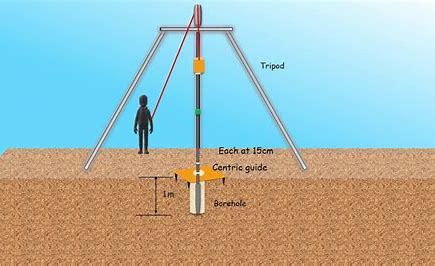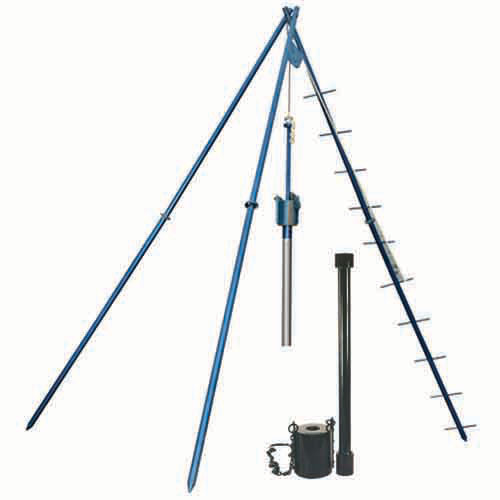This article explores the use of the standard penetration test to determine the bearing capacity of foundations

The Standard Penetration Test (SPT) is a widely used in-situ testing method for determining soil properties and assessing foundation bearing capacities. Developed in the early 20th century, the SPT has become an established method in geotechnical engineering due to its simplicity, cost-effectiveness, and reliability. Standard Penetration Test helps engineers understand subsurface conditions, which is critical for designing safe and efficient foundations for buildings and other structures.
Historically, the SPT was developed to improve the accuracy of soil property measurements, replacing more subjective methods that relied heavily on visual inspection and empirical rules. This test provides valuable data on soil strength, density, and other properties by driving a split-barrel sampler into the ground using a standardized hammer (See featured image). The number of blows required to penetrate a specific depth, known as the N-value, serves as a measure of soil resistance, which can be correlated with various soil characteristics, including bearing capacity.
Today, the SPT is now a standard procedure for geotechnical site investigations worldwide. Its use is very crucial in determining the bearing capacity of foundations, ensuring that structures are founded on solid stratum capable of supporting their loads. Engineers use SPT results to validate soil conditions, estimate settlement, and design foundations that are both safe and economical.
This article explores the fundamentals of the standard penetration tests as a method of measuring soil bearing capacity. The article only introduces the subject and does not attempt to cover all aspects of the method. However, further learning may be achieved by considering the texts in the ‘sources and citation‘ aspect of the article.
The Standard Penetration Test Procedure
The Standard Penetration Test involves several key steps to ensure consistent and accurate results. As stated in the last section, the standard penetration tests, as the name implies involves using an object to penetrate the ground and then measuring the resistance of penetration.
First, a borehole is drilled to the desired depth using a rotary drilling rig. A split-barrel sampler, typically 50.8 mm in outer diameter and 35 mm in inner diameter, is then lowered into the borehole. The sampler is driven into the soil by dropping a 63.5 kg hammer from a height of 760 mm (Figure 1). The number of blows required to drive the sampler 300 mm into the soil is recorded as the N-value. This process is repeated at different depths to obtain a profile of the subsurface conditions.

The N-value is an essential parameter in geotechnical engineering. It provides insights into soil density, strength, and other characteristics. It also helps engineers classify soil types and assess their suitability for supporting various types of foundations. However, the raw N-value must be corrected for several factors, including overburden pressure, borehole diameter, hammer energy, rod length, and sampler type, to ensure accurate and consistent results across different sites.
Correcting the N-value for overburden pressure is particularly important, as soil resistance increases with depth due to the weight of the overlying soil. The corrected N-value, known as the N60 value, accounts for these factors and provides a more reliable measure of soil properties. This corrected value can then be used to estimate the bearing capacity of foundations, which is crucial for designing safe and economical structures.
Correlation Between N-Value and Bearing Capacity
The bearing capacity of a foundation is a measure of its ability to support the loads imposed by a structure without undergoing excessive settlement or failure. It is a critical parameter in foundation design, as it determines the size and type of foundation required to ensure stability and safety. The SPT N-value is widely used to estimate the bearing capacity of foundations, as it provides a direct measure of soil resistance that can be correlated with various soil properties.
The correlation between N-value and bearing capacity is based on empirical relationships derived from field tests and observations. These relationships vary depending on soil type, density, and other factors, and are typically expressed as equations or charts that relate the N-value to the ultimate bearing capacity of shallow foundations. For example, the Terzaghi and Peck correlation provides a simple relationship between N-value and bearing capacity for sands and gravels, while the Meyerhof correlation is commonly used for clays and silts.
To estimate the bearing capacity of a foundation using SPT data, engineers must first determine the corrected N-value (N60) for the soil at the foundation level. This value is then used to calculate the ultimate bearing capacity using the appropriate correlation for the soil type. The ultimate bearing capacity is the maximum load that the soil can support before failure, and it is typically reduced by a global factor of safety to obtain the allowable bearing capacity, which is used for design purposes.
Correction Factors for Different Soil Types
Correcting the SPT N-value for various factors is crucial to obtaining accurate and reliable estimates of soil properties and bearing capacity. Different soil types require different correction factors to account for variations in soil behavior and strength. The most common correction factors include overburden pressure, borehole diameter, hammer energy, rod length, and sampler type. Each of these factors affects the N-value differently, and their effects must be carefully considered to ensure accurate results.
Overburden Pressure
Overburden pressure correction accounts for the increase in soil resistance with depth due to the weight of the overlying soil. This correction is essential for comparing N-values obtained at different depths or sites with varying soil densities. The corrected N-value, known as the N60 value, is calculated using a correction factor that depends on the effective overburden pressure at the test depth.
Borehole Diameter
The borehole diameter correction accounts for the effects of borehole size on the penetration resistance of the soil. Larger boreholes can reduce the confinement of the soil around the sampler, leading to lower N-values. A correction factor is applied to adjust the N-value to a standard borehole diameter of 65-115 mm, ensuring consistency across different tests.
Hammer Energy
The hammer energy correction accounts for variations in the energy delivered by the hammer to the sampler. The standard SPT hammer delivers approximately 60% of the theoretical free-fall energy, but this can vary depending on the equipment and operator. The N-value is corrected to a standard energy ratio of 60% (N60) to account for these variations and ensure consistent results.
Rod Length
The rod length correction accounts for the effects of rod length on the energy delivered to the sampler. Longer rods can absorb more energy, reducing the amount of energy transmitted to the soil. A correction factor is applied to adjust the N-value for rod lengths greater than 10 meters, ensuring that the measured resistance accurately reflects soil properties.
Sampler Type
The sampler type correction accounts for variations in sampler design and dimensions, which can affect the penetration resistance of the soil. Standard split-barrel samplers are used to ensure consistent results, but variations in sampler dimensions can affect the N-value. A correction factor is applied to adjust the N-value for non-standard samplers, ensuring that the measured resistance accurately reflects soil properties.
Worked Example
To illustrate the use of SPT data for estimating the bearing capacity of a foundation, consider a scenario where an engineer is tasked with designing a shallow foundation for a building on a site with sandy soil. The engineer conducts an SPT test at the proposed foundation level (1.5 meters below the ground surface) and obtains an N-value of 60. The following steps outline the process for estimating the bearing capacity using this data:
Step 1: Correction for Overburden Pressure
The effective overburden pressure at the test depth is calculated using the soil unit weight and the depth of the test. For this example, assume a soil unit weight of 18 kN/m³ and a test depth of 1.5 meters:
\sigma'_v=\gamma \times z =18\times1.5=27kN/m^2
The correction factor for overburden pressure (CN) can be estimated using empirical charts or equations. For sandy soils, a common equation is:
C_N=\frac{1}{0.77+0.033\sigma'_v}Substituting the calculated overburden pressure:
C_N=\frac{1}{0.77+0.033(27)}\approx 0.857The corrected N-value (N60) is then calculated by multiplying the raw N-value by the correction factor:
N_{60}=N\times C_N= 60\times0.857=51.42Step 2: Determine the Ultimate Bearing Capacity
Using the corrected N-value, the ultimate bearing capacity for sandy soils can be estimated using empirical correlations. For example, the Terzaghi and Peck correlation provides the following equation for the ultimate bearing capacity of shallow foundations in sandy soils:
q_u=0.1\times N_{60}\times \sigma'_vSubstituting the corrected N-value and overburden pressure:
q_u=0.1\times 51.42\times27 =138.8
Step 3: Apply a Factor of Safety:
The ultimate bearing capacity is typically divided by a factor of safety (FS) to obtain the allowable bearing capacity, which is used for design purposes. A common factor of safety for shallow foundations is 2.5:
q_{safe}=\frac{q_{ult}}{2.5}=\frac{138.8}{2.5}=55.5kN/m^2Therefore, the allowable bearing capacity for the foundation at this site is 55.5 kN/m². This value can be used to design a foundation that safely supports the building loads without causing excessive settlement or failure.
Note that in this case only correction for overburden has been applied. For more practical cases, the other correction parameters need to be applied.
Conclusion
The Standard Penetration Test (SPT) is an essential tool in geotechnical engineering for assessing soil properties and determining the bearing capacity of foundations. By providing a direct measure of soil resistance, the SPT enables engineers to estimate the bearing capacity of various soil types and design foundations that are safe, stable, and economical. Correcting the N-value for various factors, such as overburden pressure, borehole diameter, hammer energy, rod length, and sampler type, is crucial to obtaining accurate and reliable results. Understanding these correction factors and their applications is essential for interpreting SPT data and ensuring the safety and stability of engineered structures.
See: Field Methods of Measuring Soil Bearing Capacity
Sources & Citations
- Terzaghi, K., & Peck, R. B. (1948). Soil Mechanics in Engineering Practice. John Wiley & Sons.
- Meyerhof, G. G. (1956). “Penetration Tests and Bearing Capacity of Cohesionless Soils.” Journal of the Soil Mechanics and Foundations Division, ASCE, 82(1), 1-19.
- Bowles, J. E. (1996). Foundation Analysis and Design (5th ed.). McGraw-Hill.
- Das, B. M. (2015). Principles of Foundation Engineering (8th ed.). Cengage Learning.
- ASTM D1586-11 (2011). “Standard Test Method for Standard Penetration Test (SPT) and Split-Barrel Sampling of Soils.” ASTM International.